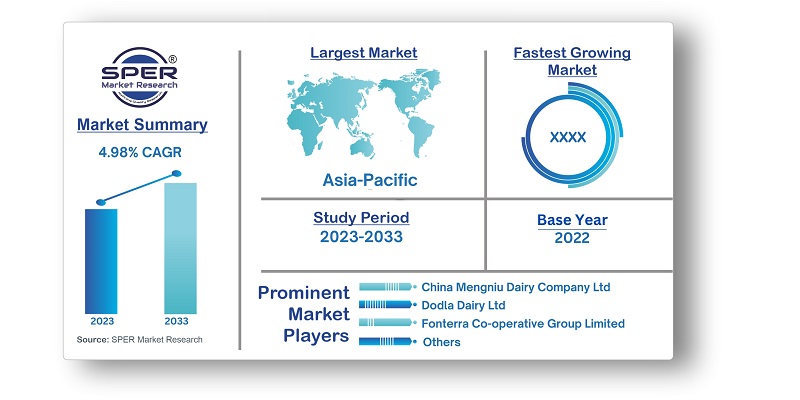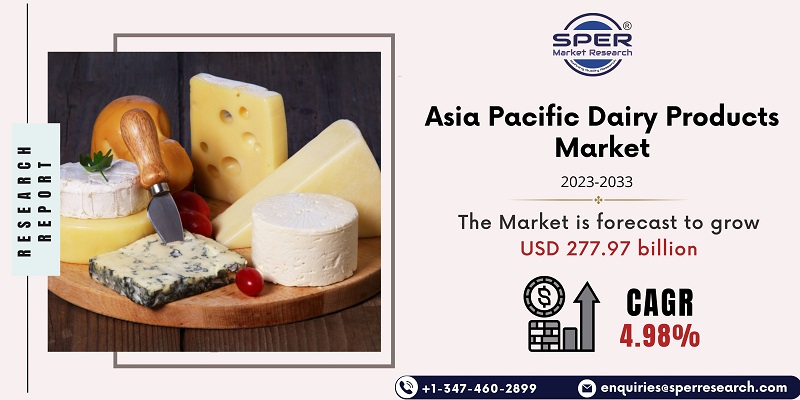
Asia Pacific Dairy Products Market Growth, Size, Trends, Share, Revenue, Scope and Future Outlook
Asia Pacific Dairy Products Market Size- By Product- Regional Outlook, Competitive Strategies and Segment Forecast to 2033
| Published: Jan-2024 | Report ID: FOOD2409 | Pages: 1 - 157 | Formats*: |
| Category : Food & Beverages | |||
- September 2023: Bellamy's Australia, a manufacturer of organic infant formula, was purchased by China Mengniu for USD $1 billion.
- In the region of North China where the company is headquartered, Yili established a dairy hub to produce fresh milk, baby formula, and cheese.


| Report Metric | Details |
| Market size available for years | 2019-2033 |
| Base year considered | 2022 |
| Forecast period | 2023-2033 |
| Segments covered | By Product |
| Regions covered | China, India, Japan, South Korea, Australia and New Zealand, Indonesia, Thailand, Malaysia, Vietnam, Philippines, Singapore, Rest of Asia-Pacific |
| Companies Covered | China Mengniu Dairy Company Ltd, Dodla Dairy Ltd, Fonterra Co-operative Group Limited, Gujarat Co-operative Milk Marketing Federation Ltd, Hatsun Agro Product Ltd, Inner Mongolia Yili Industrial Group Co. Ltd, Karnataka Cooperative Milk Producers Federation Ltd, Meiji Dairies Corporation, Nestlé SA, Yakult Honsha Co. Ltd, and others |
- Consumers
- Retail and Wholesale Businesses
- Food and Beverage Industry
- Health and Fitness Industry
- Specialized Diets and Lifestyles
| By Product: |
|
| By Region: |
|
- Asia Pacific Dairy Products Market Size (FY’2023-FY’2033)
- Overview of Asia Pacific Dairy Products Market
- Segmentation of Asia Pacific Dairy Products Market By Product (Anhydrous Milk Fat (AMF), Cream, Butter, Flavoured Milk, Fluid Milk/UHT Milk, Non-fat Dry Milk, Skimmed Milk Powder, Whole Milk Powder.
- Expansion Analysis of Asia Pacific Dairy Products Market
- Problems and Obstacles in Asia Pacific Dairy Products Market
- Competitive Landscape in the Asia Pacific Dairy Products Market
- Impact of COVID-19 and Demonetization on Asia Pacific Dairy Products Market
- Details on Current Investment in Asia Pacific Dairy Products Market
- Competitive Analysis of Asia Pacific Dairy Products Market
- Prominent Players in the Asia Pacific Dairy Products Market
- SWOT Analysis of Asia Pacific Dairy Products Market
- Asia Pacific Dairy Products Market Future Outlook and Projections (FY’2023-FY’2033)
- Recommendations from Analyst
1.1. Scope of the report1.2. Market segment analysis
2.1. Research data source2.1.1. Secondary Data2.1.2. Primary Data2.1.3. SPER’s internal database2.1.4. Premium insight from KOL’s2.2. Market size estimation2.2.1. Top-down and Bottom-up approach2.3. Data triangulation
4.1. Driver, Restraint, Opportunity and Challenges analysis4.1.1. Drivers4.1.2. Restraints4.1.3. Opportunities4.1.4. Challenges4.2. COVID-19 Impacts of the Asia Pacific Dairy Products Market
5.1. SWOT Analysis
5.1.1. Strengths5.1.2. Weaknesses5.1.3. Opportunities5.1.4. Threats5.2. PESTEL Analysis5.2.1. Political Landscape5.2.2. Economic Landscape5.2.3. Social Landscape5.2.4. Technological Landscape5.2.5. Environmental Landscape5.2.6. Legal Landscape5.3. PORTER’s Five Forces5.3.1. Bargaining power of suppliers5.3.2. Bargaining power of buyers5.3.3. Threat of Substitute5.3.4. Threat of new entrant5.3.5. Competitive rivalry5.4. Heat Map Analysis
6.1. Asia Pacific Dairy Products Market Manufacturing Base Distribution, Sales Area, Product Type6.2. Mergers & Acquisitions, Partnerships, Product Launch, and Collaboration in Asia Pacific Dairy Products Market
7.1. Asia Pacific Dairy Products Market Value Share and Forecast, By Product, 2023-20337.2. Anhydrous Milk Fat (AMF)7.3. Cream, Butter7.4. Flavoured Milk7.5. Fluid Milk/UHT Milk7.6. Non-fat Dry Milk7.7. Skimmed Milk Powder7.8. Whole Milk Powder (WMP)
8.1. Asia Pacific Dairy Products Market Size and Market Share
9.1. Asia Pacific Dairy Products Market Size and Market Share By Technology (2019-2026)9.2. Asia Pacific Dairy Products Market Size and Market Share By Technology (2027-2033)
10.1. Asia Pacific Dairy Products Market Size and Market Share By Product (2019-2026)10.2. Asia Pacific Dairy Products Market Size and Market Share By Product (2027-2033)
11.1. Asia Pacific Dairy Products Market Size and Market Share By Region (2019-2026)11.2. Asia Pacific Dairy Products Market Size and Market Share By Region (2027-2033)11.3. China11.4. India11.5. Japan11.6. South Korea11.7. Australia and New Zealand11.8. Indonesia11.9. Thailand11.10. Malaysia11.11. Vietnam11.12. Philippines11.13. Singapore11.14. Rest of Asia-Pacific
13. List of Abbreviations12.1. China Mengniu Dairy Company Ltd12.1.1. Company details12.1.2. Financial outlook12.1.3. Product summary12.1.4. Recent developments12.2. Dodla Dairy Ltd12.2.1. Company details12.2.2. Financial outlook12.2.3. Product summary12.2.4. Recent developments12.3. Fonterra Co-operative Group Limited12.3.1. Company details12.3.2. Financial outlook12.3.3. Product summary12.3.4. Recent developments12.4. Gujarat Co-operative Milk Marketing Federation Ltd12.4.1. Company details12.4.2. Financial outlook12.4.3. Product summary12.4.4. Recent developments12.5. Hatsun Agro Product Ltd12.5.1. Company details12.5.2. Financial outlook12.5.3. Product summary12.5.4. Recent developments12.6. Inner Mongolia Yili Industrial Group Co. Ltd12.6.1. Company details12.6.2. Financial outlook12.6.3. Product summary12.6.4. Recent developments12.7. Karnataka Cooperative Milk Producers Federation Ltd12.7.1. Company details12.7.2. Financial outlook12.7.3. Product summary12.7.4. Recent developments12.8. Meiji Dairies Corporation12.8.1. Company details12.8.2. Financial outlook12.8.3. Product summary12.8.4. Recent developments12.9. Nestlé SA12.9.1. Company details12.9.2. Financial outlook12.9.3. Product summary12.9.4. Recent developments12.10. Yakult Honsha Co. Ltd12.10.1. Company details12.10.2. Financial outlook12.10.3. Product summary12.10.4. Recent developments12.11. Others
SPER Market Research’s methodology uses great emphasis on primary research to ensure that the market intelligence insights are up to date, reliable and accurate. Primary interviews are done with players involved in each phase of a supply chain to analyze the market forecasting. The secondary research method is used to help you fully understand how the future markets and the spending patterns look likes.
The report is based on in-depth qualitative and quantitative analysis of the Product Market. The quantitative analysis involves the application of various projection and sampling techniques. The qualitative analysis involves primary interviews, surveys, and vendor briefings. The data gathered as a result of these processes are validated through experts opinion. Our research methodology entails an ideal mixture of primary and secondary initiatives.



Frequently Asked Questions About This Report
PLACE AN ORDER
Year End Discount
Sample Report
Pre-Purchase Inquiry
NEED CUSTOMIZATION?
Request CustomizationCALL OR EMAIL US
100% Secure Payment






Related Reports
Our Global Clients
Our data-driven insights have influenced the strategy of 200+ reputed companies across the globe.




















